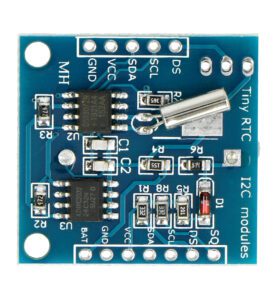Table of Contents:
Measuring time in human history was less precise than it is today due to the lack of advanced technology and tools we have today.
Methods had limited accuracy especially in case of changes in weather conditions or even local customs.
Today, such situations cannot be mentioned.
RTC clocks - what are they?
History of the real-time clock (RTC) dates back to the early days of computers, or rather computer science, when the need for perfectly accurate timing became increasingly important.
The first RTC clocks were mechanical clocks that used a quartz oscillator to maintain a constant frequency, which was then used to drive a mechanical counter.
When a voltage is applied to such a crystal, it deforms in a characteristic way, leading to a mechanical oscillation with a fixed resonant frequency.
These mechanical vibrations are converted to an electrical signal by appropriate electronics, resulting in a stable periodic signal.
Over time, RTCs have become more sophisticated and have begun to use digital technology.
The first digital RTC clock was developed in the 1970s.
It was developed in the 1970s and used a microprocessor to keep track of time.
These early digital RTC clocks were used in a variety of applications, including computers, watches and other electronic devices.
Today, RTC clocks are an essential part of many electronic devices, including computers, smartphones and other digital devices.
They serve to provide unquestionable assurance that the time and date displayed on these devices are always accurate – even when our device is turned off.
Application of the RTC clock
Since real-time clock (RTC) is a type of clock that gives the current time even when the power is turned off or the system is reset.
This is because an RTC clock is usually powered by a small battery that continues to provide power even if the main power supply is lost – this can be used to mark time with events or schedule tasks to be completed at a specific time.
Below we have gathered potential advantages in the form of real-time clock functionality.
- Keep track of the current time and date, even when the power is turned off or the system is reset.
- Maintaining the accuracy of other system clocks, which can vary over time.
- Synchronize events across multiple systems or devices, which is important for distributed systems or applications that require high-precision synchronization.
- Provide a reference point for measuring the duration of events or calculating elapsed time.
- Enabling the scheduling of tasks to be completed at specific times.
- Provide a source of timing information that is not subject to network latency or other external factors.
- Enable the system to automatically adjust to time changes due to daylight saving time or other time zone changes.
- Ensure the security and integrity of time-sensitive data, such as financial transactions or security logs.
Modern real-time clocks
Without RTC clock today’s personal computers and mobile devices would have to rely on time synchronization every time they are turned on, which would be cumbersome and less convenient for users.
RTC clocks are used in alarm systems, surveillance cameras, access controls and other security systems to accurately time events such as alarms, event logging and video recording.
Without RTC clocks, these systems could not function properly, since they rely on providing accurate timestamps for events.
Without a precise RTC clock, GPS navigation systems could operate much less accurately and with delays even costing human health and lives.
In the dawn of IoT (Internet of Things, Internet of Things), our smart building controller sensors also need to be synchronized, not to mention banking, stock market systems or even military installations.
Interesting parameters of today’s RTC clocks – often based on high-precision quartz crystals and advanced electronic circuitry – include maximum error per month, i.e. acceptable error usually at the millisecond level, indicators of long-term stability or initialization accuracy at startup – the faster and more accurately you can synchronize to real time after startup, the better.
For transactional and financial systems, an error in the RTC clock could make it difficult to track and audit transactions, in medical applications it could lead to incorrect timestamps for examinations or surgical procedures, and in navigation and localization it could lead to disasters due to position calculation errors – that’s why their reliability is so important to us.
Testing requires not only proper configuration at the outset, but also observation over an extended period of time to verify that there are no spikes in readings, and that functions are actually performed when the integrated device or system is powered down.
RTC clocks in electronics
Integrations, integrations and more compatibility. In small electronics, such as projects using the Arduino and microcontrollers, real-time clocks (RTCs) are readily used for a variety of applications that require accurate time tracking.
The instinctively obvious ones are digital clocks with LCDs or LEDs.
In projects involving automation systems, smart homes or appliance control, RTC clocks can be used to schedule and execute specific tasks at specific points in time.
For example, a home automation system can be programmed to turn on lights at specific times or assist in changing the desired temperature depending on the time of day.
Where time-based data logging is required, RTC clocks can be used to mark each data sample with an accurate timestamp.
This makes it possible to analyze the data later and understand when and how it was collected.
How useful was this post?
Click on a star to rate it!
Average rating 4 / 5. Vote count: 1
No votes so far! Be the first to rate this post.




















